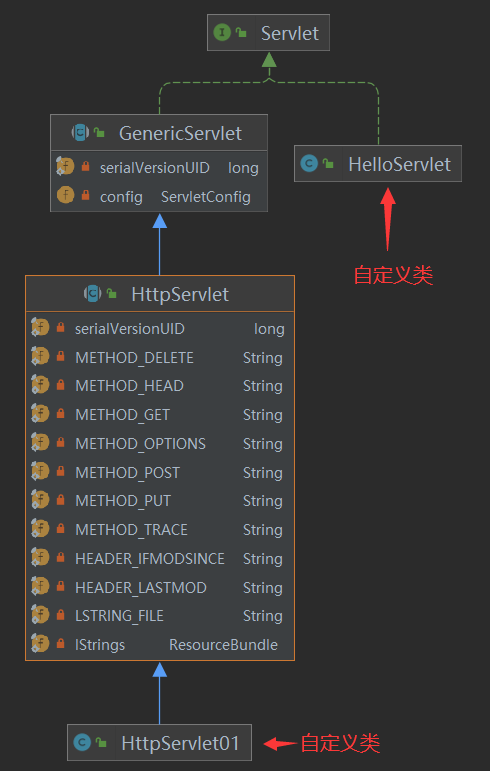

Tomcat深入浅出——Servlet(二) - lx-Meteor
source link: https://www.cnblogs.com/lx-meteor/p/16446966.html
Go to the source link to view the article. You can view the picture content, updated content and better typesetting reading experience. If the link is broken, please click the button below to view the snapshot at that time.

一、Servlet简介
Servlet类最终开发步骤:
- 第一步:编写一个Servlet类,直接继承HttpServlet
- 第二步:重写doGet方法或者doPost方法,重写哪个我说的算!
- 第三步:将Servlet类配置到web.xml文件当中
- 第四步:准备前端的页面(form表单),指定请求路径即可
我们来了解一下GenericServlet:
- 其中的GenericServlet实现了很多方法,只保留了一个抽象方法,就是我们经常用的service方法。
- 这或许就是为了更简洁一点吧,我们每次不需要在像实现Servlet接口一样,将全部的抽象方法都实现。
- 根据他的类图可知,HttpServlet继承了GenericServlet这个类,那么它为什么要继承GenericServlet呢?
我们来了解一下HttpServlet:
protected void service(HttpServletRequest req, HttpServletResponse resp) throws ServletException, IOException { String method = req.getMethod(); long lastModified; if (method.equals("GET")) { lastModified = this.getLastModified(req); if (lastModified == -1L) { this.doGet(req, resp); } else { long ifModifiedSince; try { ifModifiedSince = req.getDateHeader("If-Modified-Since"); } catch (IllegalArgumentException var9) { ifModifiedSince = -1L; }
if (ifModifiedSince < lastModified / 1000L * 1000L) { this.maybeSetLastModified(resp, lastModified); this.doGet(req, resp); } else { resp.setStatus(304); } } } else if (method.equals("HEAD")) { lastModified = this.getLastModified(req); this.maybeSetLastModified(resp, lastModified); this.doHead(req, resp); } else if (method.equals("POST")) { this.doPost(req, resp); } else if (method.equals("PUT")) { this.doPut(req, resp); } else if (method.equals("DELETE")) { this.doDelete(req, resp); } else if (method.equals("OPTIONS")) { this.doOptions(req, resp); } else if (method.equals("TRACE")) { this.doTrace(req, resp); } else { String errMsg = lStrings.getString("http.method_not_implemented"); Object[] errArgs = new Object[]{method}; errMsg = MessageFormat.format(errMsg, errArgs); resp.sendError(501, errMsg); }
}
- 这段是HttpServlet中实现的Service方法的源码,我们可以清楚的了解到,Tomcat已经把这个Service写好了,我们只需要去实现
doGet()、doPost()等等这些请求的方法就可以了。 - 因为这个Service会自己判断,我们进行访问的是什么请求,然后自动找到相应的方法进行处理。
二、两种设计模式
2.1适配器模式
适配器:适配器就是一种适配中间件,它存在于不匹配的二者之间,用于连接二者,将不匹配变得匹配,简单点理解就是平常所见的转接头,转换器之类的存在。
public abstract class Test implements MyInterface{ public void m1() { }
public void m2() { }
public void m3() { }
public void m4() { }
public void m5() { } //这是一个适配器 //在创建一个接口的实现类,我们将常用的方法设置为抽象的方法 //这样我们只需要继承该类,然后实现方法即可 public abstract void test(); }
- 这样做的优点就是下次我们只需要去继承Test类,实现我们经常使用的test()方法就可以了。
- 使我们的减少了冗余的代码量
- 同时你也会发现这个就和GenericServlet去继承Servlet这个接口是一样的
- 这就是适配器设计模式,其实很简单,也有利于我们更加理解抽象类的作用和接口的使用
2.2 模板设计方法模式
模板方法模式:是一种行为设计模式, 它在超类中定义了一个算法的框架, 允许子类在不修改结构的情况下重写算法的特定步骤。
-
模板方法模式建议将算法分解为一系列步骤, 然后将这些步骤改写为方法, 最后在 “模板方法” 中依次调用这些方法。 步骤可以是 抽象的, 也可以有一些默认的实现。 为了能够使用算法, 客户端需要自行提供子类并实现所有的抽象步骤。 如有必要还需重写一些步骤 (但这一步中不包括模板方法自身)。
-
认真的去阅读上面这段话:你就会发现他说将 算法进行分解,最后在模板中依次调用:
- 此时的你是否想起我们刚开篇介绍的HttpServlet???
- HttpServlet继承了 GenericServlet类,而GenericServlet类又实现了Servlet接口;HttpServlet里面的Service()方法你是否还记得?
protected void service(HttpServletRequest req, HttpServletResponse resp) throws ServletException, IOException { String method = req.getMethod(); long lastModified; if (method.equals("GET")) { lastModified = this.getLastModified(req); if (lastModified == -1L) { this.doGet(req, resp); } else { long ifModifiedSince; try { ifModifiedSince = req.getDateHeader("If-Modified-Since"); } catch (IllegalArgumentException var9) { ifModifiedSince = -1L; }
if (ifModifiedSince < lastModified / 1000L * 1000L) { this.maybeSetLastModified(resp, lastModified); this.doGet(req, resp); } else { resp.setStatus(304); } } } else if (method.equals("HEAD")) { lastModified = this.getLastModified(req); this.maybeSetLastModified(resp, lastModified); this.doHead(req, resp); } else if (method.equals("POST")) { this.doPost(req, resp); } else if (method.equals("PUT")) { this.doPut(req, resp); } else if (method.equals("DELETE")) { this.doDelete(req, resp); } else if (method.equals("OPTIONS")) { this.doOptions(req, resp); } else if (method.equals("TRACE")) { this.doTrace(req, resp); } else { String errMsg = lStrings.getString("http.method_not_implemented"); Object[] errArgs = new Object[]{method}; errMsg = MessageFormat.format(errMsg, errArgs); resp.sendError(501, errMsg); }
}
- 一大堆的
if、else if、else这不就是所谓的将算法分块提炼了出来吗?然后我们只需要去刻画doGet()、doPost()等方法,程序的主框架是不变的,只是其中的细节需要我们自己去实现。 - 我个人目前觉得和适配器模式比较相似,但略有不同之处。
三、Servlet对象的声明周期
3.1 Servlet对象是由谁来维护的?
- Servlet对象的创建、以及对象上方法的调用、对象的销毁这个过程,我们JavaWeb程序员是无权干预的。你可以仔细想想你什么时候new出来过一个Servlet对象。
- Servlet对象的声明周期是由Tomcat服务器负责的
- Tomcat服务器我们又可以称之为:WEB容器
- WEB容器来管理Servlet对象的死活
3.2 Servlet认知强化
- 你还真可以自己new一个Servlet对象,但是并不受我们Tomcat管理,所以你自己new出来的Servlet对象,死活和Tomcat没有关系。
- Tomcat创建的Servlet对象,这些Servlet都会被放到一个集合当中(HashMap),只有放到HashMap集合的Servlet才能够被Tomcat容器管理。
- Tomcat容器底层应该有一个HashMap这样的集合,在这个集合当中存储了Servlet对象和请求路径之间的关系,我想此时你更能够想到为什么我们总是在xml中如此定义?
- 我们可以将Servlet对象称之为假单例模式,因为Servlet只有一个对象呀。🐔
- 配置在web.xml对应Servlet程序的标签下添加
<load-on-startup>1</load-on-startup>配置,指定改Servlet对象在Web应用启动时创建
3.3 关于Servlet中的方法
- 通过Servlet中的方法,我们就可以了解到它的生命周期、运行机制。
- 无参数构造方法、init方法只在第一次用户发送请求的时候执行
-
只要用户发送一次请求,service方法必然会被Tomcat调用一次。
-
关于Servlet类中方法的调用次数:
- 构造方法只执行一次
- init方法只执行一次
- service方法:用户发送n次请求执行n次
- destroy方法:只执行一次
什么时候使用destroy方法:
- 通常在destroy方法当中,进行资源的关闭,马上对象要被销毁了,还有什么没有关闭的,抓紧时间关闭资源。
四、Servlet映射问题
- 只要是前端发送的请求,就必须要写项目名!
- 当我们进行转发的时候需要加上"/":
request.getRequestDispatcher('/b'); - 当我们在web.xml中配置路径时,需要加上
<url-pattern>/helloServlet</url-pattern>
url-pattern匹配规则:
- "/":弱的 全路径匹配
- ".do":以特殊方式结尾的匹配
- "/*":强的 全路径匹配
- "/hello/*":有前缀的 所以匹配
五、HttpServletRequest
- 首先HttpServletRequest这个接口实现了ServletRequest接口,那么他们两个有什么区别呢?
5.1 GET请求参数
● 在浏览器的url里发送,以查询字符串方式拼接参数(?key=value&key1=value1)
● 使用Ajax,设置请求类型为GET,在请求url后拼接查询字符串
● 用form表单发送
5.2 POST请求参数
● form表单传输,指定请求方式为POST,默认Content-Type为application/x-www-form-urlencoded
● Ajax传输,指定请求方式为POST,必须添加Content-Type为application/x-www-form-urlencoded;charset=utf-8
● 附上前端代码
- 对于Tomcat的Servlet内容就总结这么多,若想深入学习等待后续更新。
- 我将会继续更新关于Java方向的学习知识,感兴趣的小伙伴可以关注一下。
- 文章写得比较走心,用了很长时间,绝对不是copy过来的!
- 尊重每一位学习知识的人,同时也尊重每一位分享知识的人。
- 😎你的点赞与关注,是我努力前行的无限动力。🤩
__EOF__
Recommend
About Joyk
Aggregate valuable and interesting links.
Joyk means Joy of geeK




